Reservoir Permeability Evolution during the Process of CO2-Enhanced Coalbed Methane Recovery
Abstract
:1. Introduction
2. Modeling
- (1)
- The CBM reservoir exhibits isothermal behavior, the process of gas adsorption/desorption only occurs in the matrix and obeys the role of Langmuir isothermal behavior [35].
- (2)
- The CBM reservoir is saturated with mixture gas that contains only CH4 and CO2 (a water phase is not included in the model).
- (3)
- The CBM reservoir is considered as a dual-porosity media consisting of matrix and fractures. Each medium is homogeneous and isotropic.
- (4)
- The deformation of the CBM reservoir is infinitesimal.
- (5)
- The gas flow satisfies Darcy’s law in the matrix and the fracture system.
2.1. Dynamic Porosity and Permeability
2.1.1. Dynamic Porosity and Permeability of Fractures
2.1.2. Dynamic Porosity and Permeability of Matrix
2.2. Governing Equations
2.2.1. Deformation Equation
2.2.2. Binary Gas Transport
2.3. Model Implementation
3. Results and Analysis
3.1. Permeability Evolution in the Whole Simulation Area
3.1.1. Matrix Permeability Evolution
3.1.2. Fracture Permeability Evolution
3.2. Permeability Evolutions at Different Locations
3.2.1. The First Stage (I)
3.2.2. The Second Stage (II)
3.2.3. The Third Stage (III)
3.3. Some Other Influencing Factors
3.3.1. Permeability Evolution Rules at Other Locations
3.3.2. Permeability Evolution under Different Injection Pressures
3.4. Schematic to Explain the Mechanisms
4. Conclusions
- (1)
- The evolution of reservoir permeability near the IW and the PW are very different. The reason for this is because the combined effect of effective stress changes and gas adsorption and desorption. Therefore, when analyzing the evolution of reservoir permeability during the process of CO2-ECBM recovery, it is not enough to only consider the evolution of the reservoir average permeability or the evolution of the permeability at a certain location in the reservoir.
- (2)
- Since the Langmuir volumetric strain constant of CO2 is greater than that of CH4, the swelling due to the adsorption of CO2 is greater than the shrinkage due to desorption of CH4. As a result, adsorption is the main factor for the change of permeability for regions near the IW, while the change in effective stress is the main cause for the change in permeability for regions the PW. Therefore, the overall trend of the evolution of permeability of the entire reservoir shows a downward trend.
- (3)
- Permeability evolution near the wells is the most dramatic. The farther away from the well, the gentler the evolution of permeability during the process of CO2-ECBM recovery. When we increase the injection pressure of CO2, the reservoir permeability evolution becomes quicker and more dynamic.
Author Contributions
Funding
Acknowledgments
Conflicts of Interest
Abbreviations
| σ | Average principal stress (Pa) |
| σe | Effective stress (Pa) |
| p | Gas pressure (Pa) |
| α, β | Effective stress coefficients |
| K | Bulk modulus (Pa) |
| G | Shear modulus (Pa) |
| E | Elastic modulus (Pa) |
| v | Poisson’s ratio |
| εs | Sorption-induced strain |
| εv | Volumetric strain |
| k | Permeability (m2) |
| φ | Porosity |
| Kp | Bulk modulus of pore (Pa) |
| εvp | Volumetric strain of pore |
| ∆ | Increment of a variable |
| V | Volume (m3) |
| s | Length of REV (m) |
| D | Diffusion coefficient (m2/s) |
| m | Gas mass content (kg/m3) |
| w | Transfer coefficient (s−1) |
| VL | Langmuir volume (m3/kg) |
| εL | Langmuir volumetric strain |
| PL | Langmuir pressure (Pa) |
| ρc | Coal density (kg/m3) |
| T | Reservoir temperature (K) |
| Qs | Gas source or sink (kg/m3/s) |
| a | Fracture spacing (m) |
| b | Fracture aperture (m) |
| µ | Gas viscosity (Pa·s) |
| R | Gas constant (J/(mol·K)) |
| M | Gas molecular weight (kg/mol) |
| m | Matrix |
| f | Fracture |
| 0 | Initial value of the variable |
| 1 | CH4 |
| 2 | CO2 |
| F | Free gas |
| a | Standard state |
References
- Liu, J.; Chen, Z.; Elsworth, D.; Qu, H.; Chen, D. Interactions of multiple processes during CBM extraction: A critical review. Int. J. Coal Geol. 2011, 87, 175–189. [Google Scholar] [CrossRef]
- Yu, H.; Zhou, G.; Fan, W.; Ye, J. Predicted CO2 enhanced coalbed methane recovery and CO2 sequestration in China. Int. J. Coal Geol. 2007, 71, 345–357. [Google Scholar] [CrossRef]
- Damen, K.; Faaij, A.; Bergen, F.V.; Gale, J.; Lysen, E. Identification of early opportunities for CO2 sequestration—Worldwide screening for CO2-EOR and CO2-ECBM projects. Energy 2005, 30, 1931–1952. [Google Scholar] [CrossRef]
- Aminu, M.D.; Nabavi, S.A.; Rochelle, C.A.; Manovic, V. A review of developments in carbon dioxide storage. Appl. Energy 2017, 208, 1389–1419. [Google Scholar] [CrossRef]
- Bickle, M.J. Geological carbon storage. Nat. Geosci. 2009, 2, 815–818. [Google Scholar] [CrossRef]
- Zhu, Q.; Zhou, Q.; Li, X. Numerical simulation of displacement characteristics of CO2 injected in pore-scale porous media. J. Rock Mech. Geotech. Eng. 2016, 8, 87–92. [Google Scholar] [CrossRef]
- Wu, Y.; Liu, J.; Elsworth, D.; Chen, Z.; Connell, L.; Pan, Z. Dual poroelastic response of a coal seam to CO2 injection. Int. J. Greenh. Gas Control 2010, 4, 668–678. [Google Scholar] [CrossRef]
- Van Bergen, F.; Gale, J.; Damen, K.J.; Wildenborg, A.F.B. Worldwide selection of early opportunities for CO2-enhanced oil recovery and CO2-enhanced coal bed methane production. Energy 2004, 29, 1611–1621. [Google Scholar] [CrossRef]
- Wang, L.; Wang, Z.; Li, K.; Chen, H. Comparison of enhanced coalbed methane recovery by pure N2 and CO2 injection: Experimental observations and numerical simulation. J. Nat. Gas Sci. Eng. 2015, 23, 363–372. [Google Scholar] [CrossRef]
- Chen, Z.; Liu, J.; Elsworth, D.; Connell, L.D.; Pan, Z. Impact of CO2 injection and differential deformation on CO2 injectivity under in-situ stress conditions. Int. J. Coal Geol. 2010, 81, 97–108. [Google Scholar] [CrossRef]
- Shi, J.Q.; Durucan, S. A model for changes in coalbed permeability during primary and enhanced methane recovery. SPE Reserv. Eval. Eng. 2005, 8, 291–299. [Google Scholar] [CrossRef]
- White, C.M.; Smith, D.H.; Jones, K.L.; Goodman, A.L.; Jikich, S.A.; LaCount, R.B.; Dubose, S.B.; Ozdemir, E.; Morsi, B.I.; Schroeder, K.T. Sequestration of carbon dioxide in coal with enhanced coalbed methane recovery—A review. Energy Fuels 2005, 19, 659–724. [Google Scholar] [CrossRef]
- Pan, Z.; Connell, L.D. Modelling permeability for coal reservoirs: A review of analytical models and testing data. Int. J. Coal Geol. 2012, 92, 1–44. [Google Scholar] [CrossRef]
- Wei, Z.; Zhang, D. Coupled fluid-flow and geomechanics for triple-porosity/dual-permeability modeling of coalbed methane recovery. Int. J. Rock Mech. Min. Sci. 2010, 47, 1242–1253. [Google Scholar] [CrossRef]
- Gu, F.; Chalaturnyk, R. Permeability and porosity models considering anisotropy and discontinuity of coalbeds and application in coupled simulation. J. Pet. Sci. Eng. 2010, 74, 113–131. [Google Scholar] [CrossRef]
- Harpalani, S.; Schraufnagel, R.A. Shrinkage of coal matrix with release of gas and its impact on permeability of coal. Fuel 1990, 69, 551–556. [Google Scholar] [CrossRef]
- Cui, X.; Bustin, R.M. Volumetric strain associated with methane desorption and its impact on coalbed gas production from deep coal seams. AAPG Bull. 2005, 89, 1181–1202. [Google Scholar] [CrossRef]
- Wang, S.; Elsworth, D.; Liu, J. A mechanistic model for permeability evolution in fractured sorbing media. J. Geophys. Res. Solid Earth 2012. [Google Scholar] [CrossRef]
- Zang, J.; Wang, K. Gas sorption-induced coal swelling kinetics and its effects on coal permeability evolution: Model development and analysis. Fuel 2017, 189, 164–177. [Google Scholar] [CrossRef]
- Liu, J.; Chen, Z.; Elsworth, D.; Miao, X.; Mao, X. Evolution of coal permeability from stress-controlled to displacement–controlled swelling conditions. Fuel 2011, 90, 2987–2997. [Google Scholar] [CrossRef]
- Kumar, H.; Elsworth, D.; Mathews, J.P.; Liu, J.; Pone, D. Effect of CO2 injection on heterogeneously permeable coalbed reservoirs. Fuel 2014, 135, 509–521. [Google Scholar] [CrossRef]
- Chen, Z.; Liu, J.; Elsworth, D.; Pan, Z.; Wang, S. Roles of coal heterogeneity on evolution of coal permeability under unconstrained boundary conditions. J. Nat. Gas Sci. Eng. 2013, 15, 38–52. [Google Scholar] [CrossRef]
- Seidle, J.P.; Jeansonne, M.W.; Erickson, D.J. Application of matchstick geometry to stress dependent permeability in coals. In Proceedings of the SPE Rocky Mountain Regional Meeting, Casper, WY, USA, 18–21 May 1992. [Google Scholar]
- Seidle, J.R.; Huitt, L.G. Experimental measurement of coal matrix shrinkage due to gas desorption and implications for cleat permeability increases. In Proceedings of the International Meeting on Petroleum Engineering, Beijing, China, 14–17 November 1995. [Google Scholar]
- Palmer, I.; Mansoori, J. How permeability depends on stress and pore pressure in coalbeds: A new model. SPE Reserv. Eval. Eng. 1998, 1, 539–544. [Google Scholar] [CrossRef]
- Robertson, E.P.; Christiansen, R.L. Modeling permeability in coal using sorption-induced strain data. In Proceedings of the 2005 SPE Annual Conference and Technical Exhibition, Dallas, TX, USA, 9–12 October 2015. [Google Scholar] [CrossRef]
- Connell, L.D.; Lu, M.; Pan, Z. An analytical coal permeability model for tri-axial strain and stress conditions. Int. J. Coal Geol. 2010, 84, 103–114. [Google Scholar] [CrossRef]
- Zhang, H.; Liu, J.; Elsworth, D. How sorption-induced matrix deformation affects gas flow in coal seams: A new FE model. Int. J. Rock Mech. Min. Sci. 2008, 45, 1226–1236. [Google Scholar] [CrossRef]
- Liu, H.H.; Rutqvist, J. A new coal-permeability model: Internal swelling stress and fracture–matrix interaction. Transp. Porous Media 2010, 82, 157–171. [Google Scholar] [CrossRef]
- Wu, Y.; Liu, J.; Elsworth, D.; Miao, X.; Mao, X. Development of anisotropic permeability during coalbed methane production. J. Nat. Gas Sci. Eng. 2010, 2, 197–210. [Google Scholar] [CrossRef]
- Robertson, E.P. Measurement and Modeling of Sorption-Induced Strain and Permeability Changes in Coal; Idaho National Laboratory: Idaho Falls, ID, USA, 2005.
- Wang, G.; Wang, K.; Wang, S.; Elsworth, D.; Jiang, Y. An improved permeability evolution model and its application in fractured sorbing media. J. Nat. Gas Sci. Eng. 2018, 56, 222–232. [Google Scholar] [CrossRef]
- Gray, I. Reservoir engineering in coal seams: Part 1—The Physical Process of Gas Storage and Movement in Coal Seams. SPE Reserv. Eng. 1987, 2, 28–34. [Google Scholar] [CrossRef]
- Warren, J.E.; Root, P.J. The behavior of naturally fractured reservoirs. Soc. Pet. Eng. J. 1963, 3, 245–255. [Google Scholar] [CrossRef]
- Langmuir, I. The adsorption of gases on plane surfaces of glass, mica and platinum. J. Chem. Phys. 2015, 40, 1361–1403. [Google Scholar] [CrossRef]
- Elsworth, D.; Bai, M. Flow-deformation response of dual-porosity media. J. Geotech. Eng. 1992, 118, 107–124. [Google Scholar] [CrossRef]
- Chen, M.; Chen, Z. Effective stress laws for multi-porosity media. Appl. Math. Mech. 1999, 20, 1207–1213. [Google Scholar]
- Detournay, E.; Cheng, H.D. 5-fundamentals of poroelasticity. Anal. Des. Methods 1993, 140, 113–171. [Google Scholar]
- Sang, G.; Elsworth, D.; Miao, X.; Mao, X.; Wang, J. Numerical study of a stress dependent triple porosity model for shale gas reservoirs accommodating gas diffusion in kerogen. J. Nat. Gas Sci. Eng. 2016, 32, 423–438. [Google Scholar] [CrossRef]
- Biot, M.A. General theory of three-dimensional consolidation. J. Appl. Phys. 1941, 12, 155–164. [Google Scholar] [CrossRef]
- Liu, T.; Lin, B.; Yang, W. Impact of matrix–fracture interactions on coal permeability: Model development and analysis. Fuel 2017, 207, 522–532. [Google Scholar] [CrossRef]
- Xia, T.; Zhou, F.; Liu, J.; Hu, S.; Liu, Y. A fully coupled coal deformation and compositional flow model for the control of the pre-mining coal seam gas extraction. Int. J. Rock Mech. Min. Sci. 2014, 72, 138–148. [Google Scholar] [CrossRef]
- Ren, T.; Wang, G.; Cheng, Y.; Qi, Q. Model development and simulation study of the feasibility of enhancing gas drainage efficiency through nitrogen injection. Fuel 2017, 194, 406–422. [Google Scholar] [CrossRef]
- Li, X.; Elsworth, D. Geomechanics of CO2 enhanced shale gas recovery. J. Nat. Gas Sci. Eng. 2015, 26, 1607–1619. [Google Scholar] [CrossRef]
- Chilingar, G.V. Relationship between porosity, permeability, and grain-size distribution of sands and sandstones. Dev. Sedimentol. 1964, 1, 71–75. [Google Scholar]
- Zimmerman, R.W. Coupling in poroelasticity and thermoelasticity. Int. J. Rock Mech. Min. Sci. 2000, 37, 79–87. [Google Scholar] [CrossRef]
- Zimmerman, R.W.; Somerton, W.H.; King, M.S. Compressibility of porous rocks. J. Geophys. Res. Solid Earth 2012, 91, 12765–12777. [Google Scholar] [CrossRef]
- Cui, G.; Liu, J.; Wei, M.; Feng, X.; Elsworth, D. Evolution of permeability during the process of shale gas extraction. J. Nat. Gas Sci. Eng. 2018, 49, 94–109. [Google Scholar] [CrossRef]
- Liu, J.; Chen, Z.; Elsworth, D.; Miao, X.; Mao, X. Linking gas-sorption induced changes in coal permeability to directional strains through a modulus reduction ratio. Int. J. Coal Geol. 2010, 83, 21–30. [Google Scholar] [CrossRef]
- Wang, J.G.; Kabir, A.; Liu, J.; Chen, Z. Effects of non-Darcy flow on the performance of coal seam gas wells. Int. J. Coal Geol. 2012, 93, 62–74. [Google Scholar] [CrossRef]
- Wu, Y.; Liu, J.; Chen, Z.; Elsworth, D.; Pone, D. A dual poroelastic model for CO2-enhanced coalbed methane recovery. Int. J. Coal Geol. 2011, 86, 177–189. [Google Scholar] [CrossRef]
- Yin, G.; Deng, B.; Li, M.; Zhang, D.; Wang, W.; Li, W.; Shang, D. Impact of injection pressure on CO2–enhanced coalbed methane recovery considering mass transfer between coal fracture and matrix. Fuel 2017, 196, 288–297. [Google Scholar] [CrossRef]
- Mazumder, S.; Wolf, K.H.A.; Hemert, P.V.; Busch, A. Laboratory experiments on environmental friendly means to improve coalbed methane production by carbon dioxide/flue gas injection. Transp. Porous Media 2008, 75, 63–92. [Google Scholar] [CrossRef]
- Wong, S.; Law, D.; Deng, X.; Robinson, J.; Kadatz, B.; Gunter, W.D.; Ye, J.; Feng, S.; Fan, Z. Enhanced coalbed methane and CO2 storage in anthracitic coals—Micro-pilot test at South Qinshui, Shanxi, China. Int. J. Greenh. Gas Control 2007, 1, 215–222. [Google Scholar] [CrossRef]
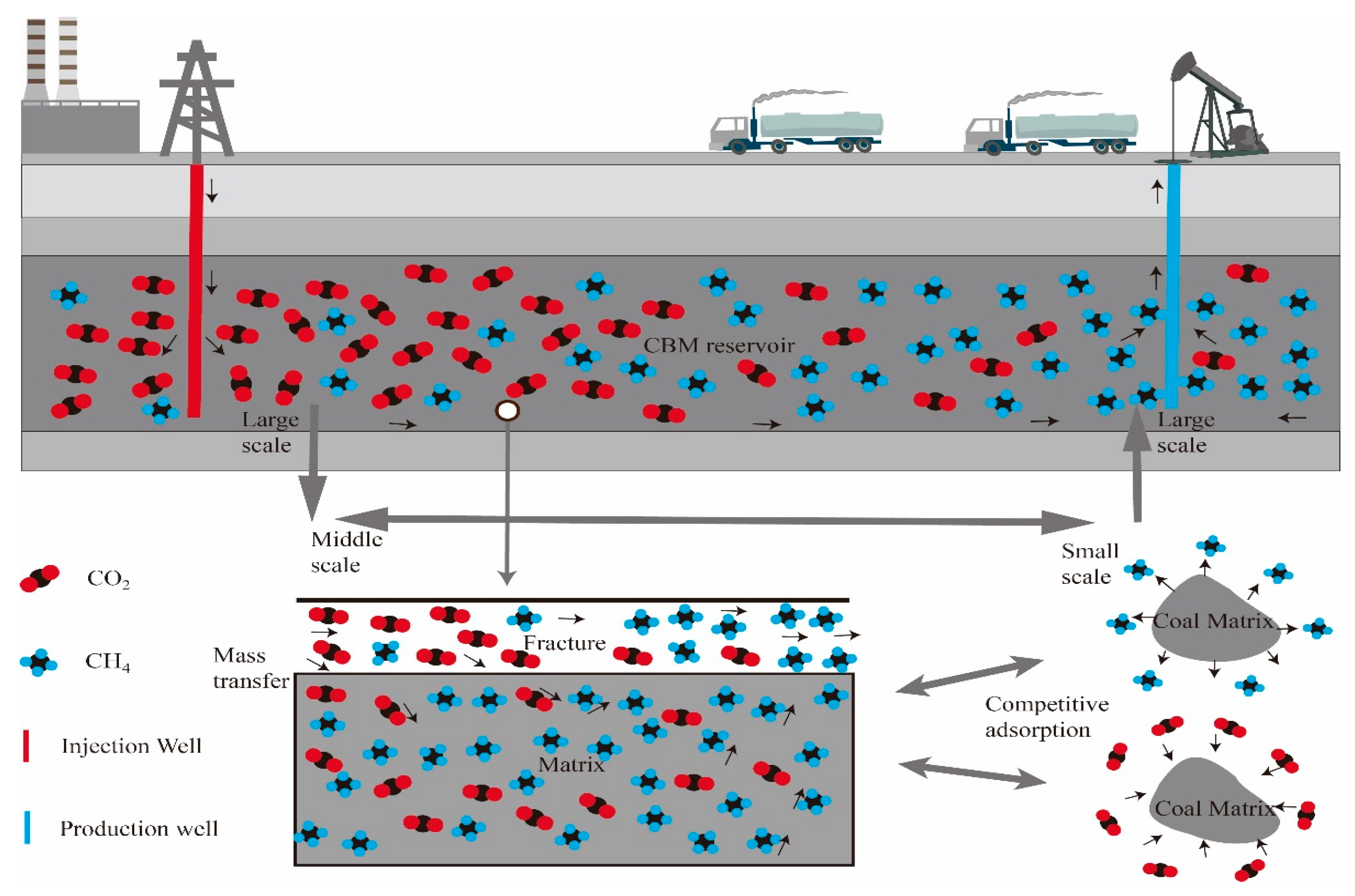
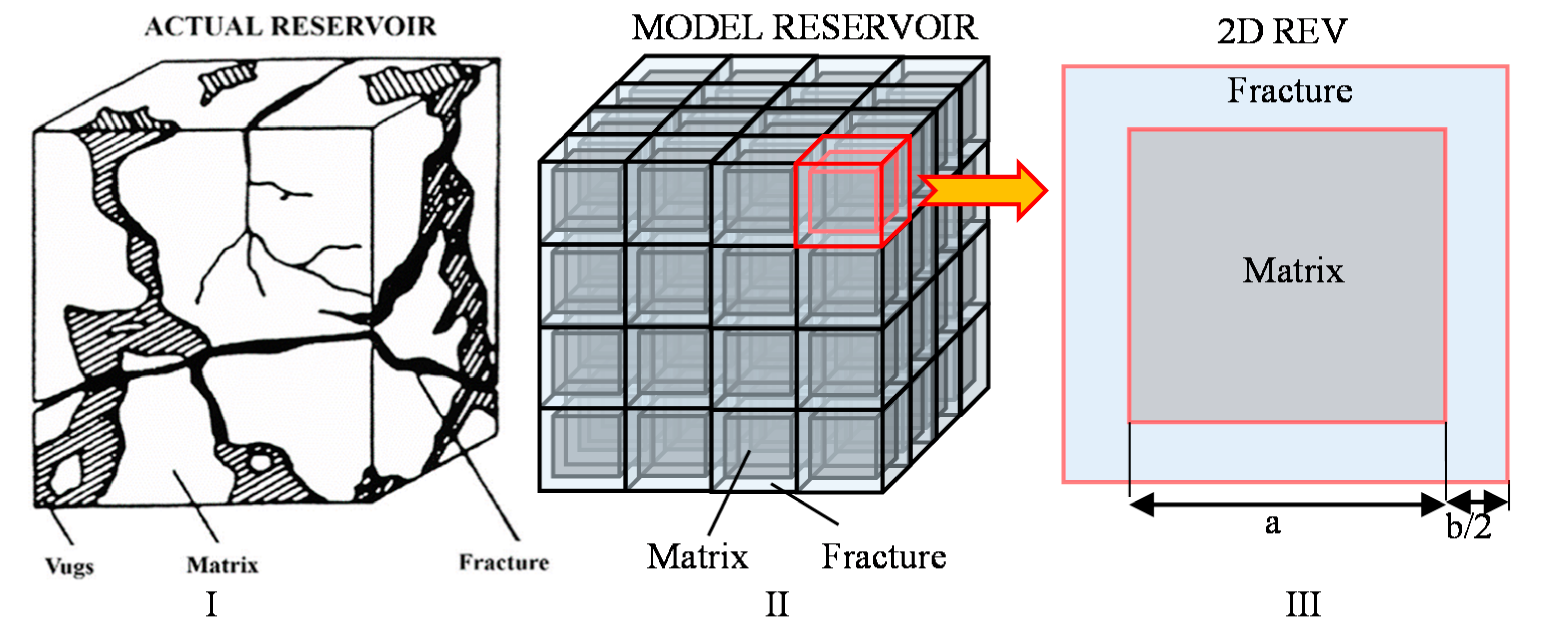
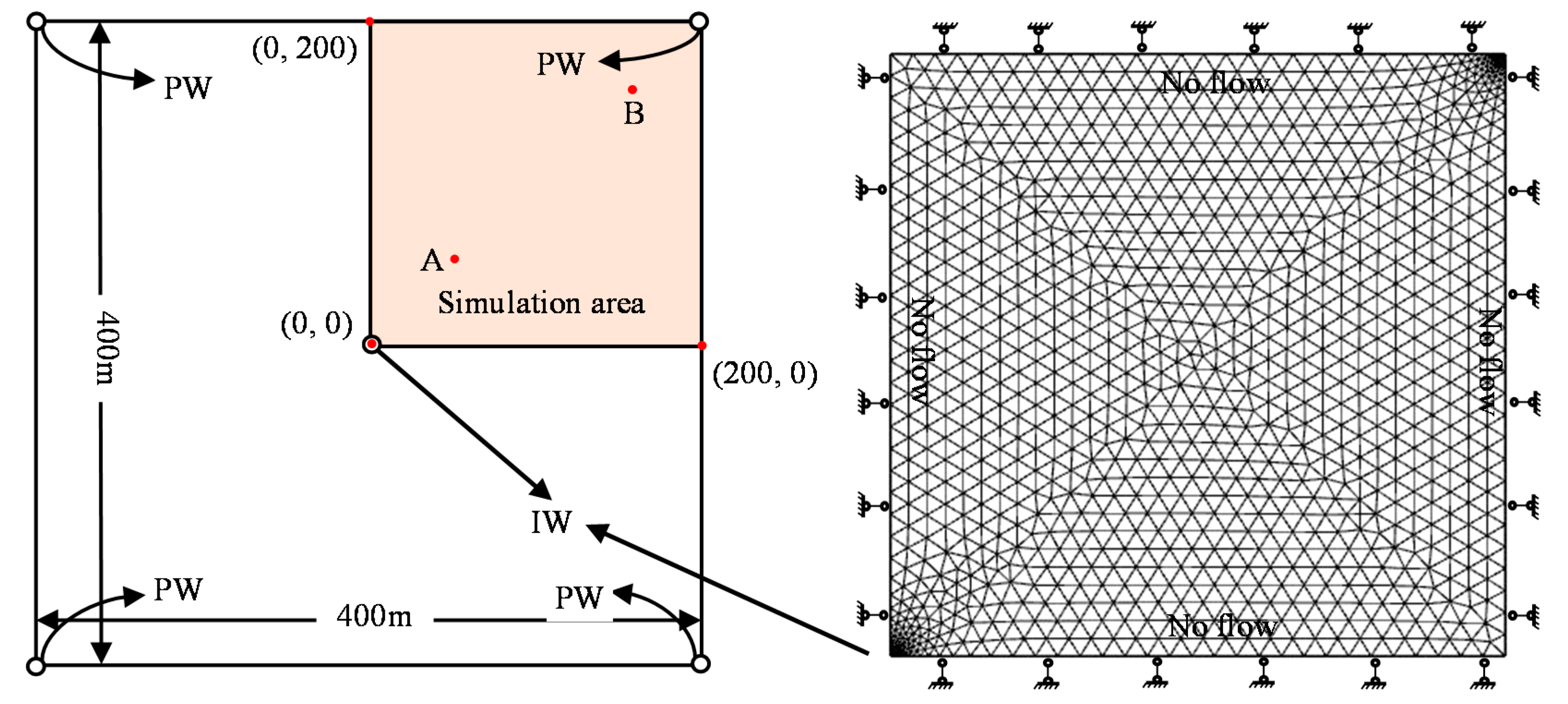

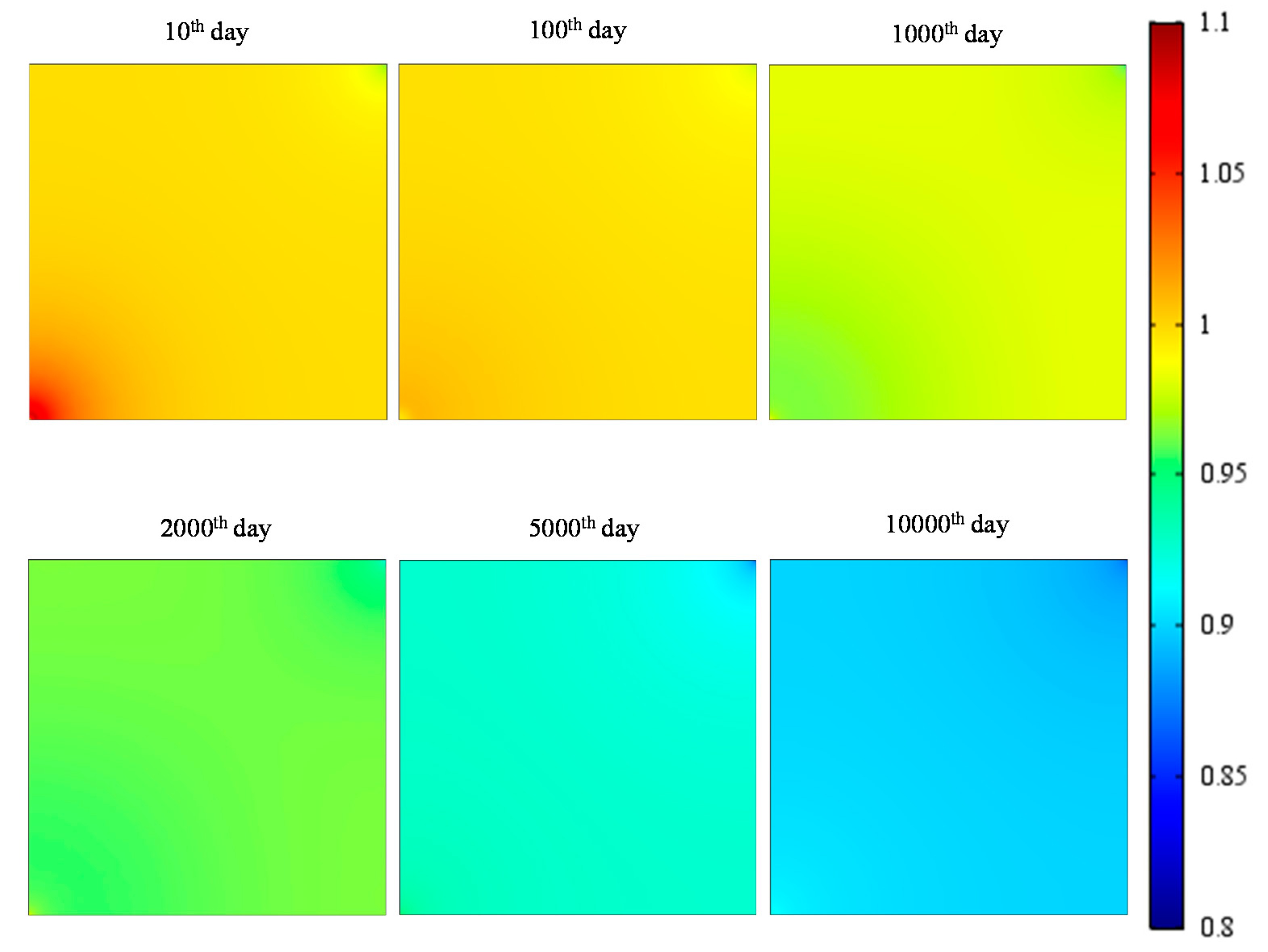


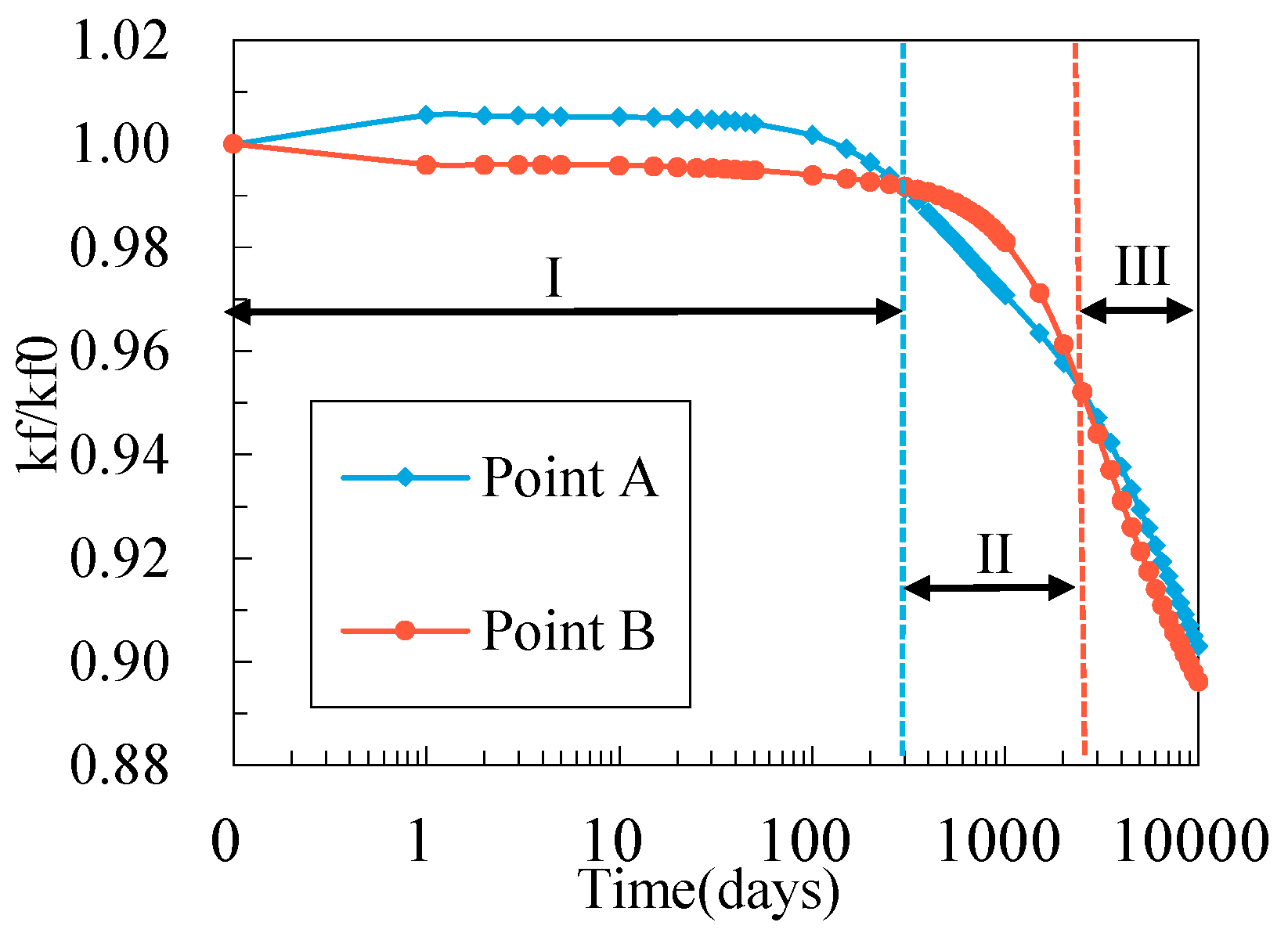
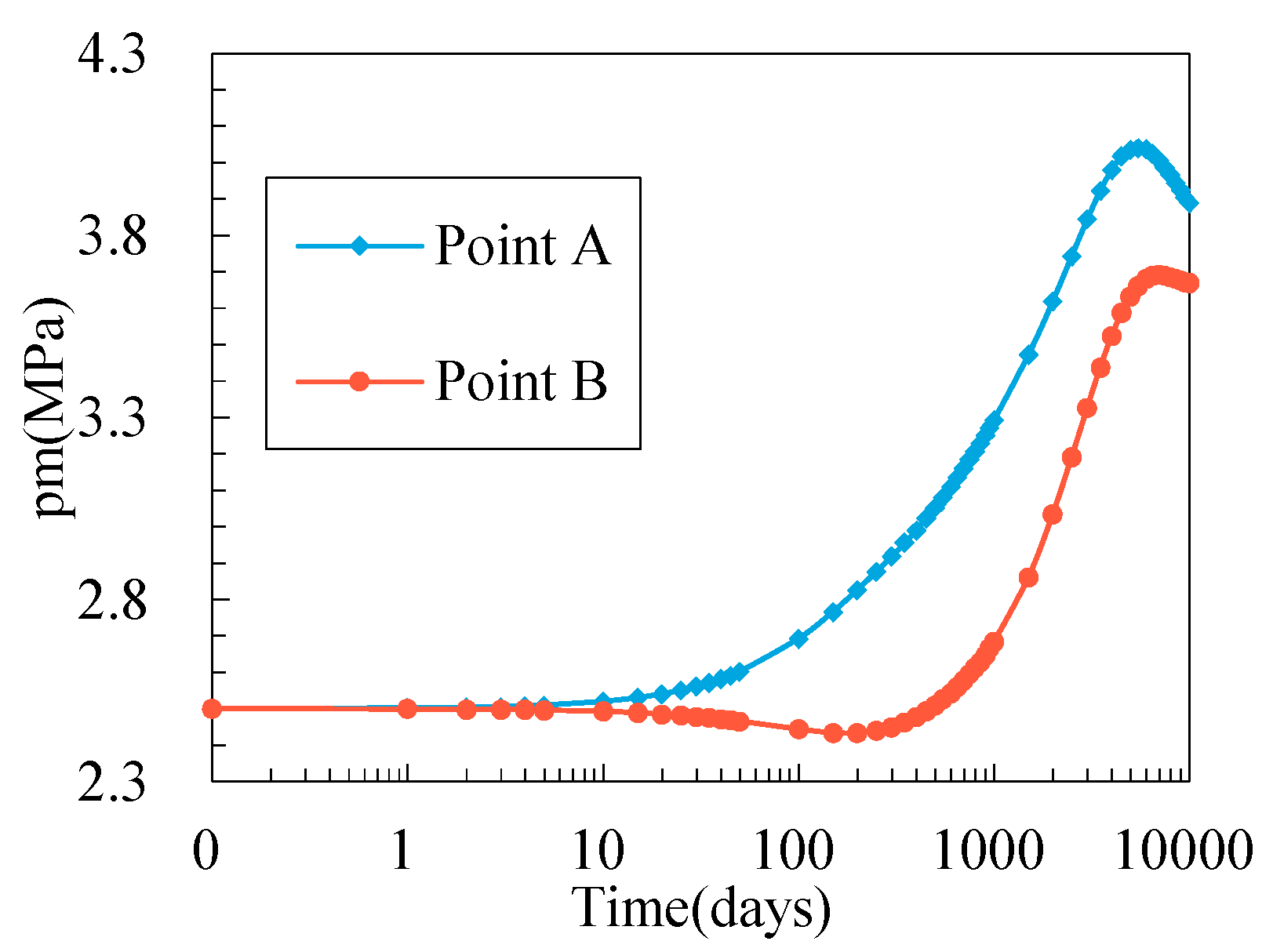
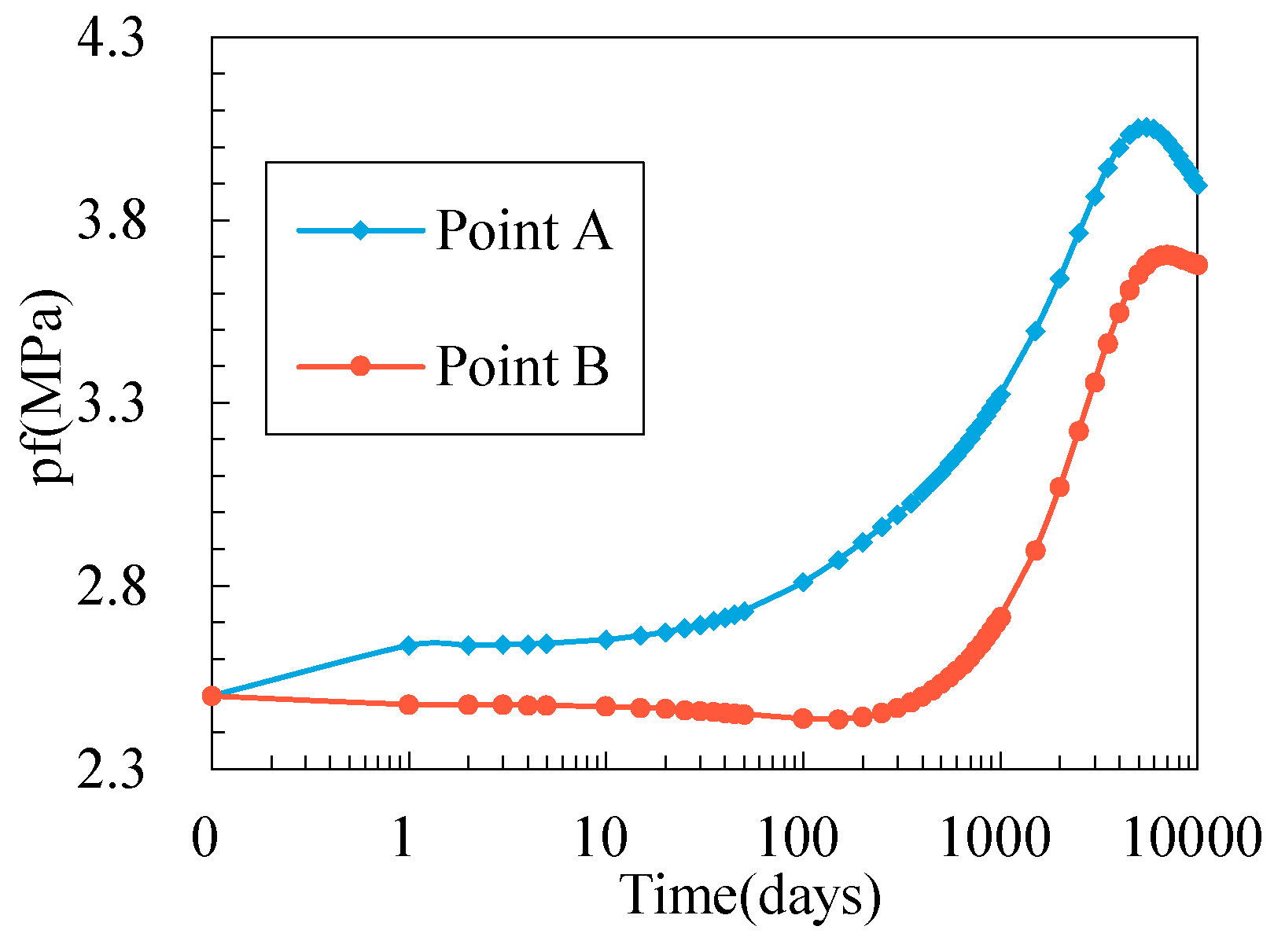
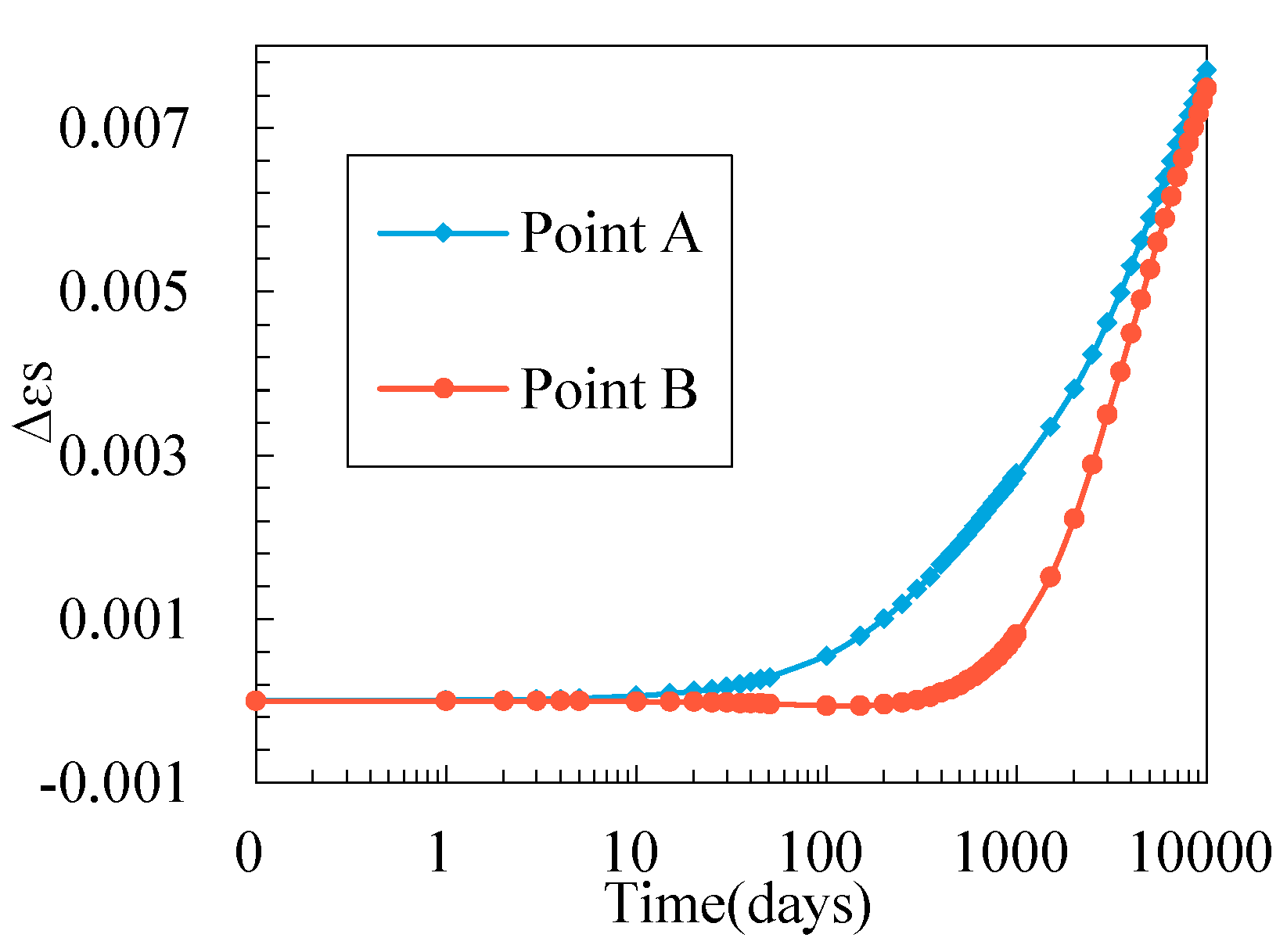
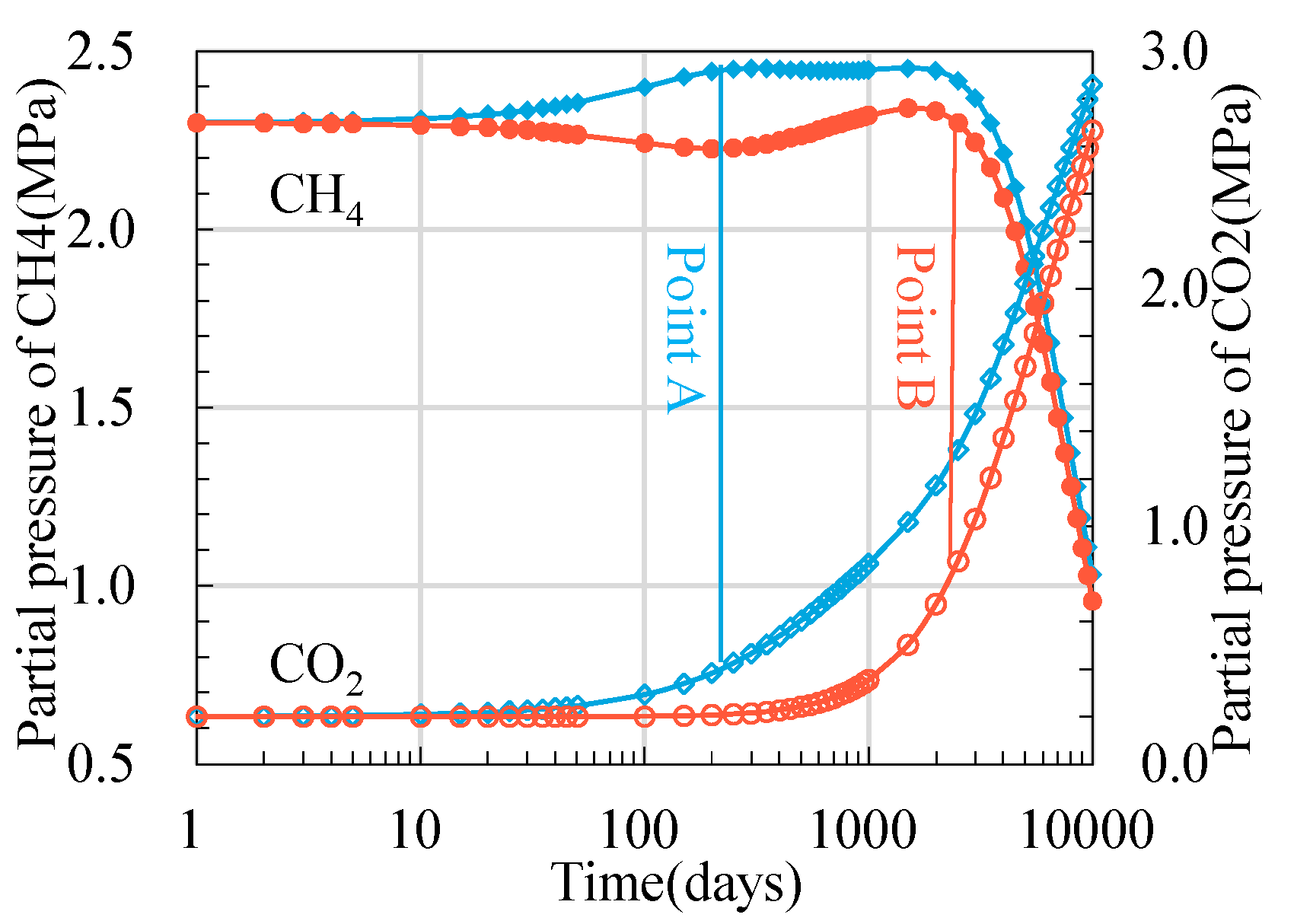
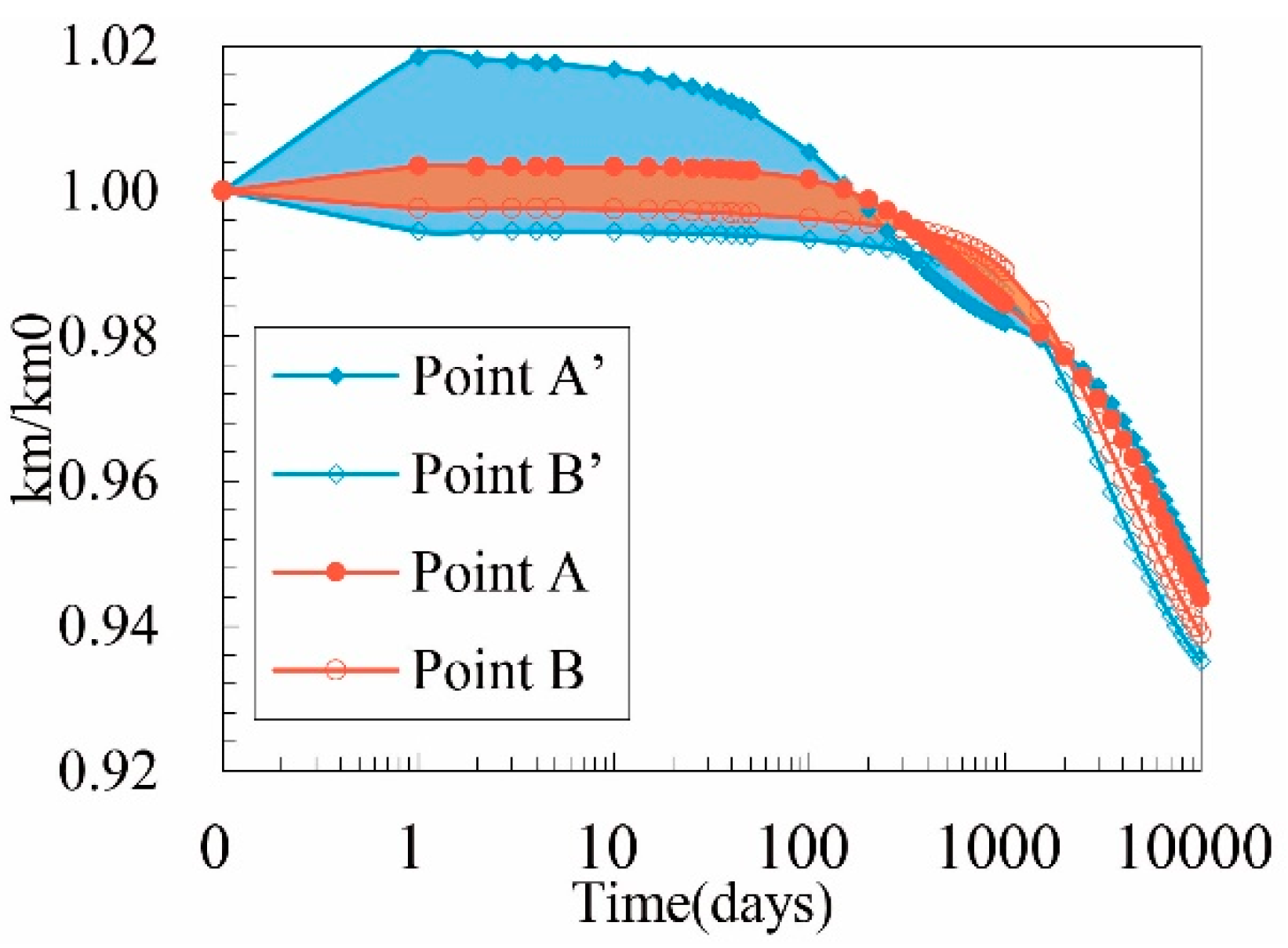

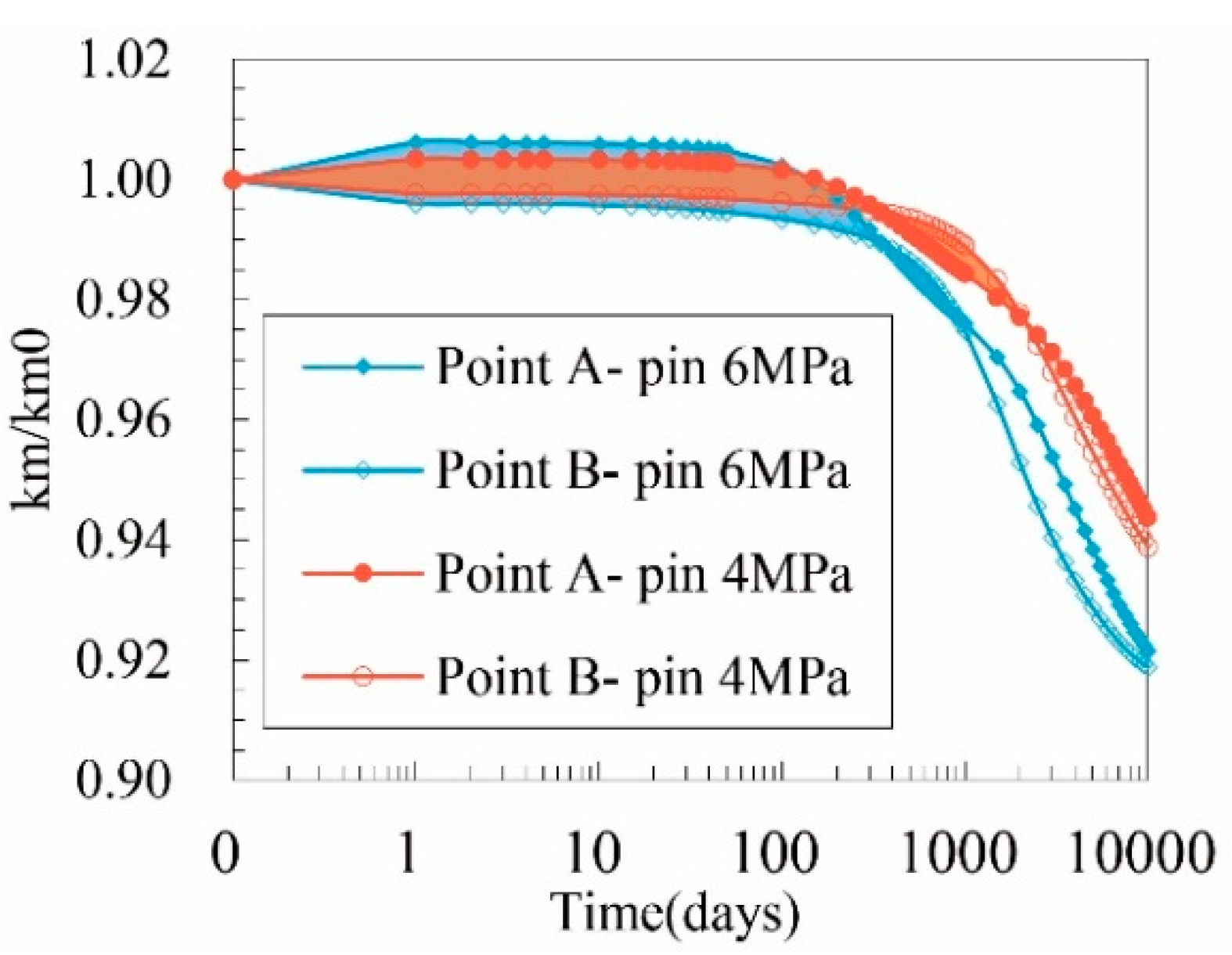
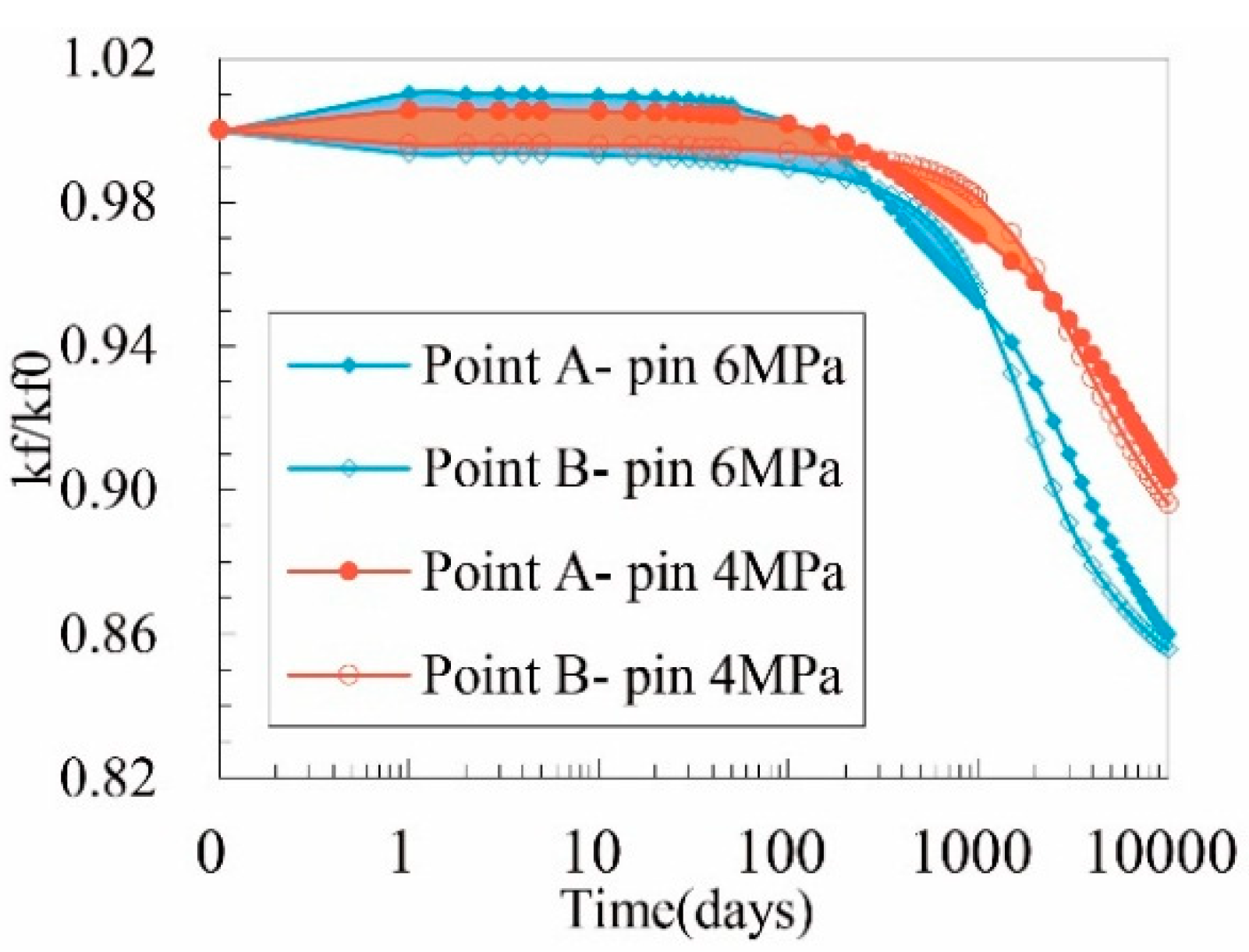
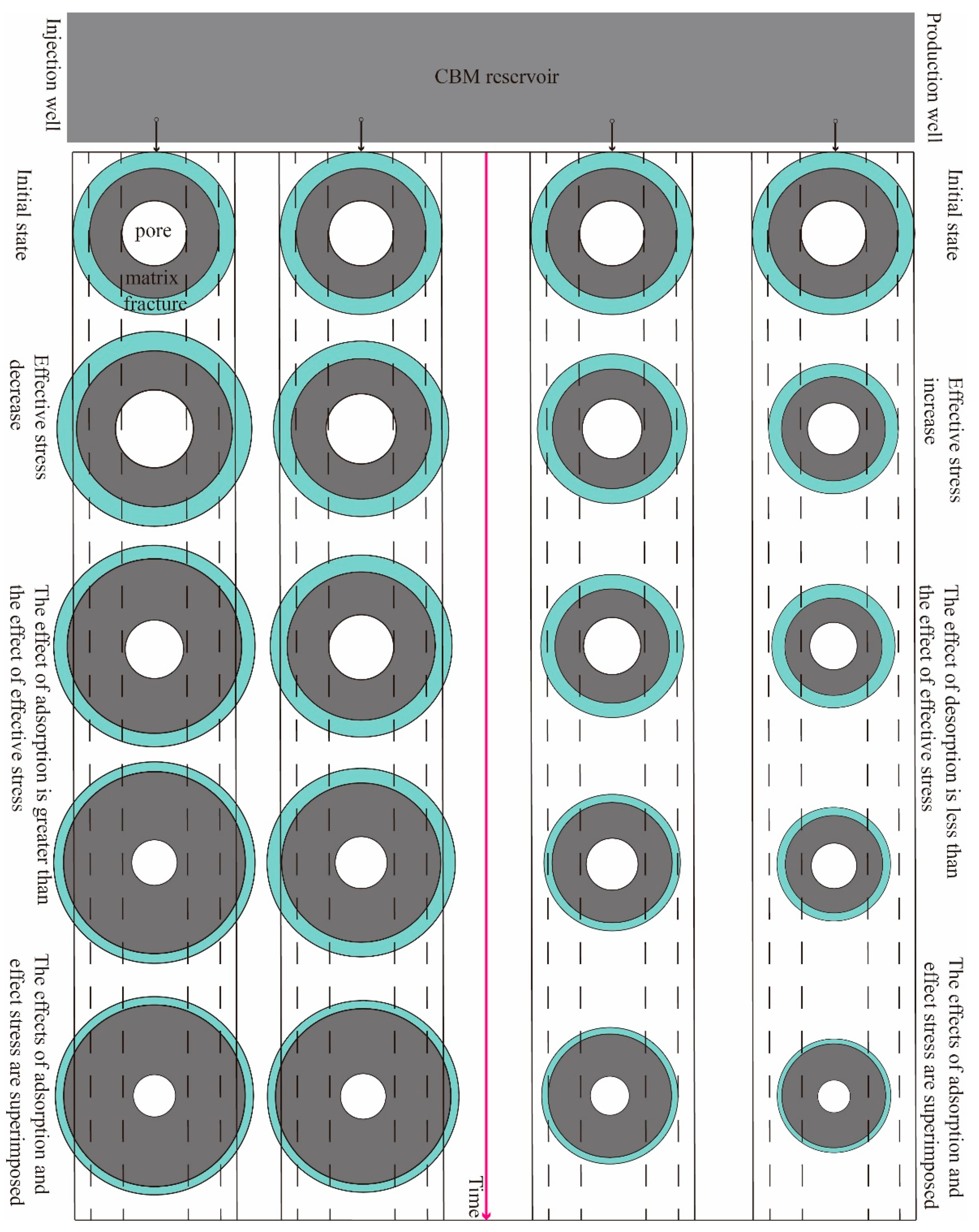
| Symbol | Value | Mean | Unit |
|---|---|---|---|
| εL1 | 0.0128 | Langmuir volume strain of CH4 | - |
| εL2 | 0.0237 | Langmuir volume strain of CO2 | - |
| VL1 | 0.0256 | Langmuir volume of CH4 | m3/kg |
| VL2 | 0.0477 | Langmuir volume of CO2 | m3/kg |
| PL1 | 2.07 × 106 | Langmuir pressure of CH4 | Pa |
| PL2 | 1.38 × 106 | Langmuir pressure of CO2 | Pa |
| μ1 | 1.15 × 10−5 | Gas viscosity of CH4 | Pa·s |
| μ2 | 1.60 × 10−5 | Gas viscosity of CO2 | Pa·s |
| D1 | 3.6 × 10−12 | Diffusion coefficient of CH4 | m2/s |
| D2 | 5.8 × 10−12 | Diffusion coefficient of CO2 | m2/s |
| φm0 | 0.04 | Intrinsic porosity of matrix | - |
| km0 | 1.0 × 10−17 | Intrinsic permeability of matrix | m2 |
| φf0 | 0.003 | Intrinsic porosity of fracture | - |
| kf0 | 1.0 × 10−15 | Intrinsic permeability of fracture | m2 |
| E | 4 × 109 | Young’s modulus of coal | Pa |
| Km | 12 × 109 | Bulk modulus of matrix | Pa |
| Kf | 1.5 × 108 | Bulk modulus of fracture | Pa |
| v | 0.32 | Poisson’s ratio | - |
© 2018 by the authors. Licensee MDPI, Basel, Switzerland. This article is an open access article distributed under the terms and conditions of the Creative Commons Attribution (CC BY) license (http://creativecommons.org/licenses/by/4.0/).
Share and Cite
Wang, G.; Wang, K.; Jiang, Y.; Wang, S. Reservoir Permeability Evolution during the Process of CO2-Enhanced Coalbed Methane Recovery. Energies 2018, 11, 2996. https://doi.org/10.3390/en11112996
Wang G, Wang K, Jiang Y, Wang S. Reservoir Permeability Evolution during the Process of CO2-Enhanced Coalbed Methane Recovery. Energies. 2018; 11(11):2996. https://doi.org/10.3390/en11112996
Chicago/Turabian StyleWang, Gang, Ke Wang, Yujing Jiang, and Shugang Wang. 2018. "Reservoir Permeability Evolution during the Process of CO2-Enhanced Coalbed Methane Recovery" Energies 11, no. 11: 2996. https://doi.org/10.3390/en11112996
APA StyleWang, G., Wang, K., Jiang, Y., & Wang, S. (2018). Reservoir Permeability Evolution during the Process of CO2-Enhanced Coalbed Methane Recovery. Energies, 11(11), 2996. https://doi.org/10.3390/en11112996






